Giáo trình Hướng dẫn chẩn đoán và điều trị các bệnh sản phụ khoa - Nguyễn Viết Tiến
Sẩy thai là hiện tượng kết thúc thai nghén trước khi thai có thể sống được. Với khái niệm này, sẩy thai được định nghĩa là trường hợp thai bị tống ra khỏi buồng tử cung trước 22 tuần hay cân nặng của thai dưới 500g.
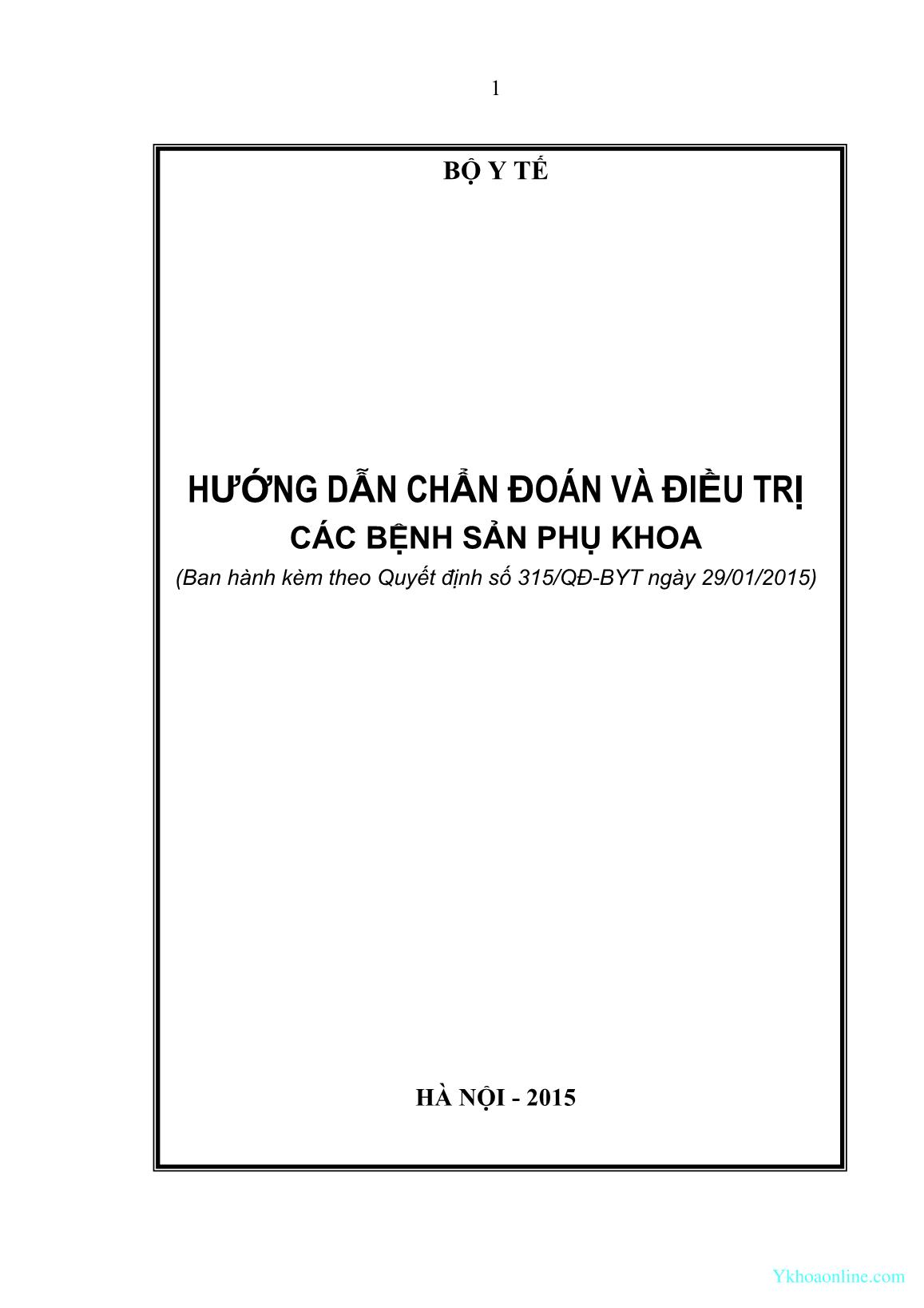
Trang 1
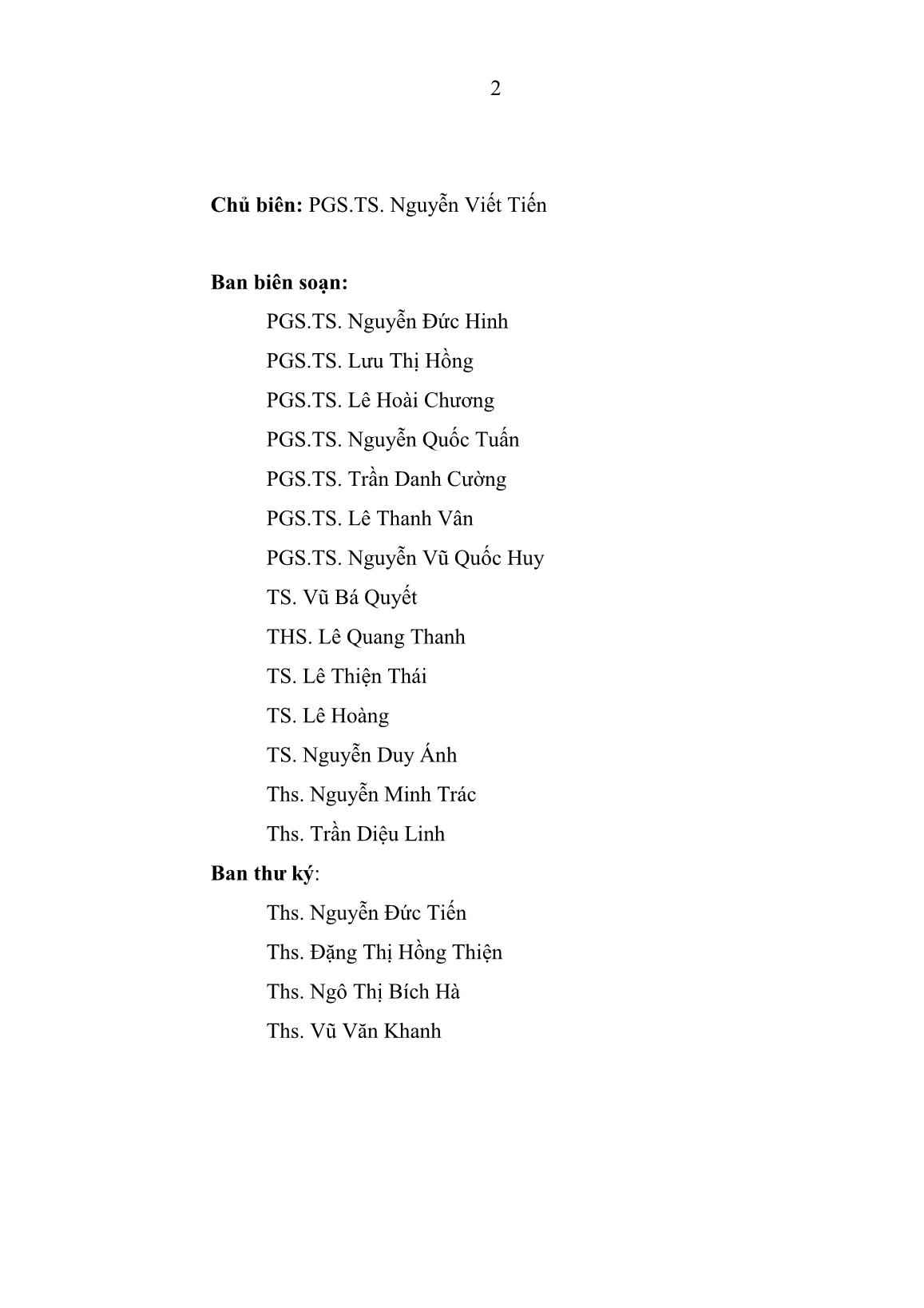
Trang 2
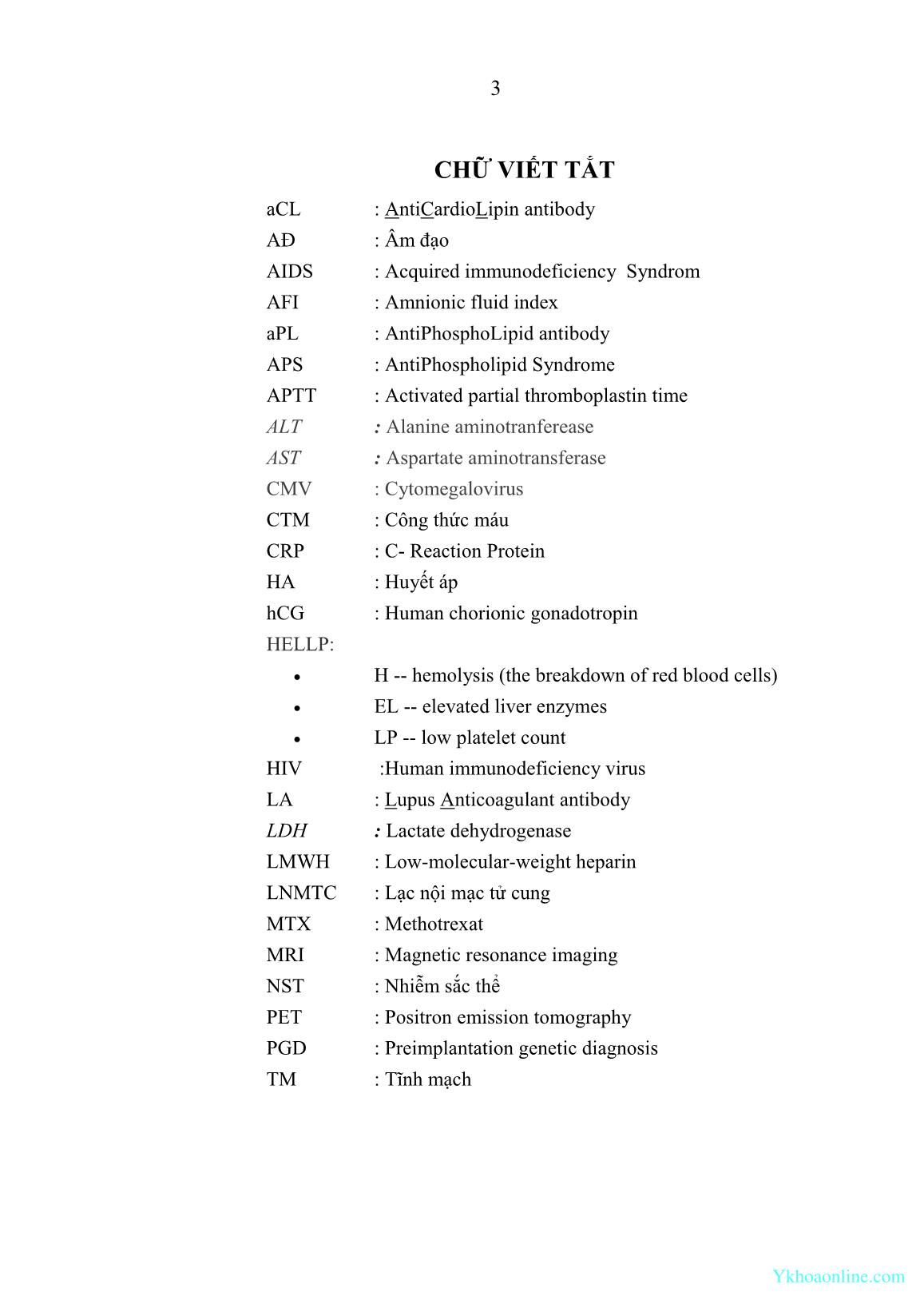
Trang 3
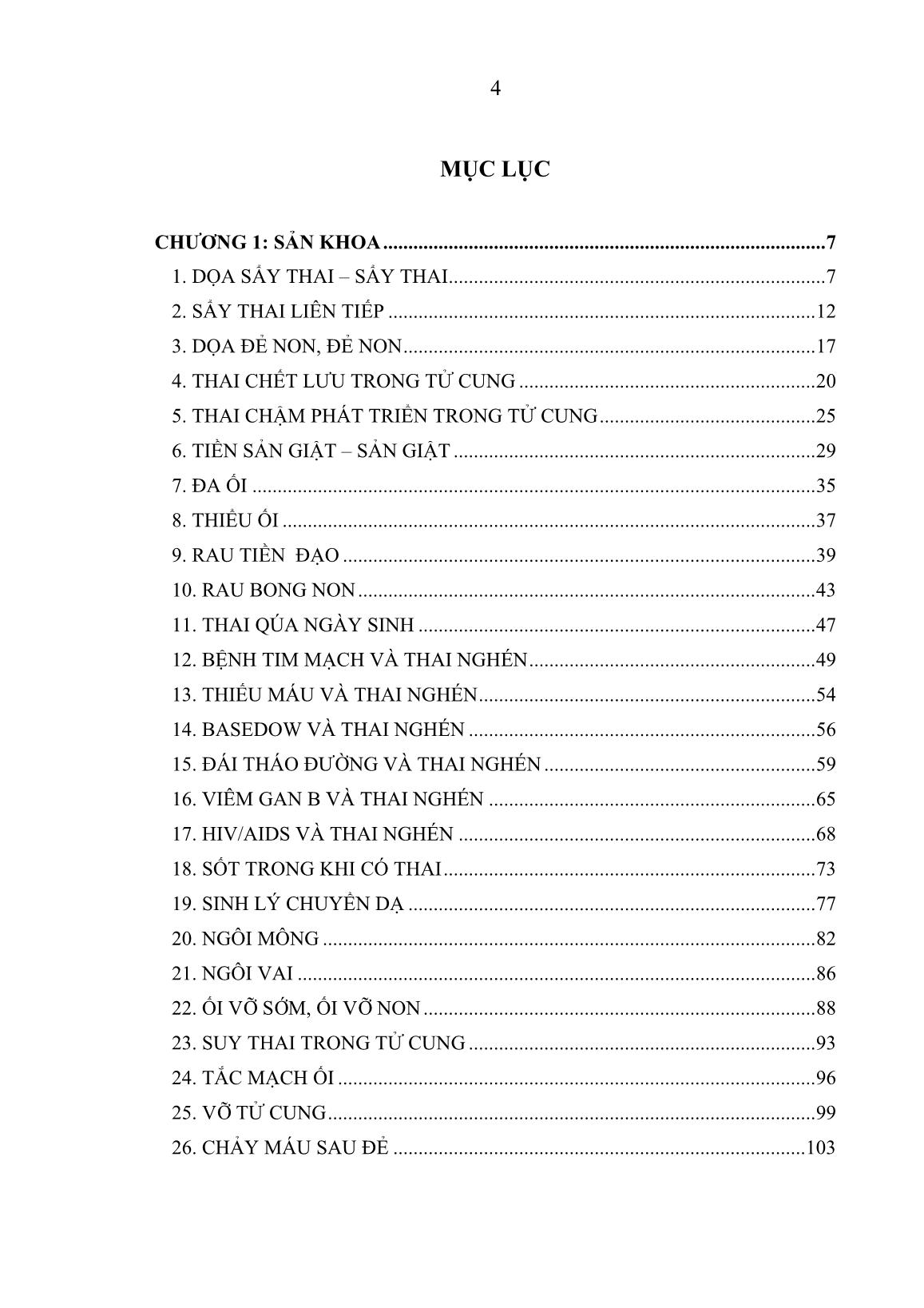
Trang 4

Trang 5

Trang 6
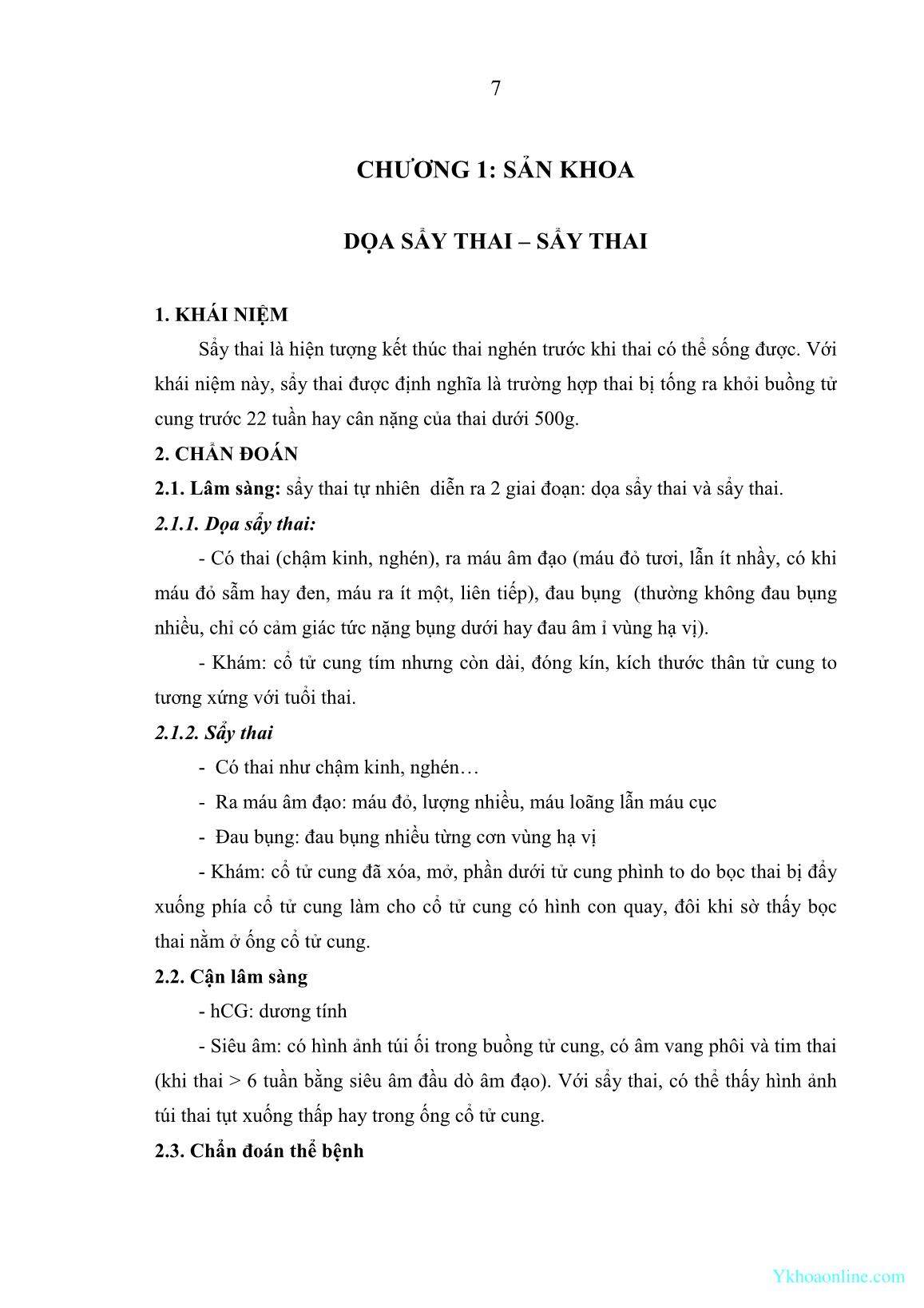
Trang 7
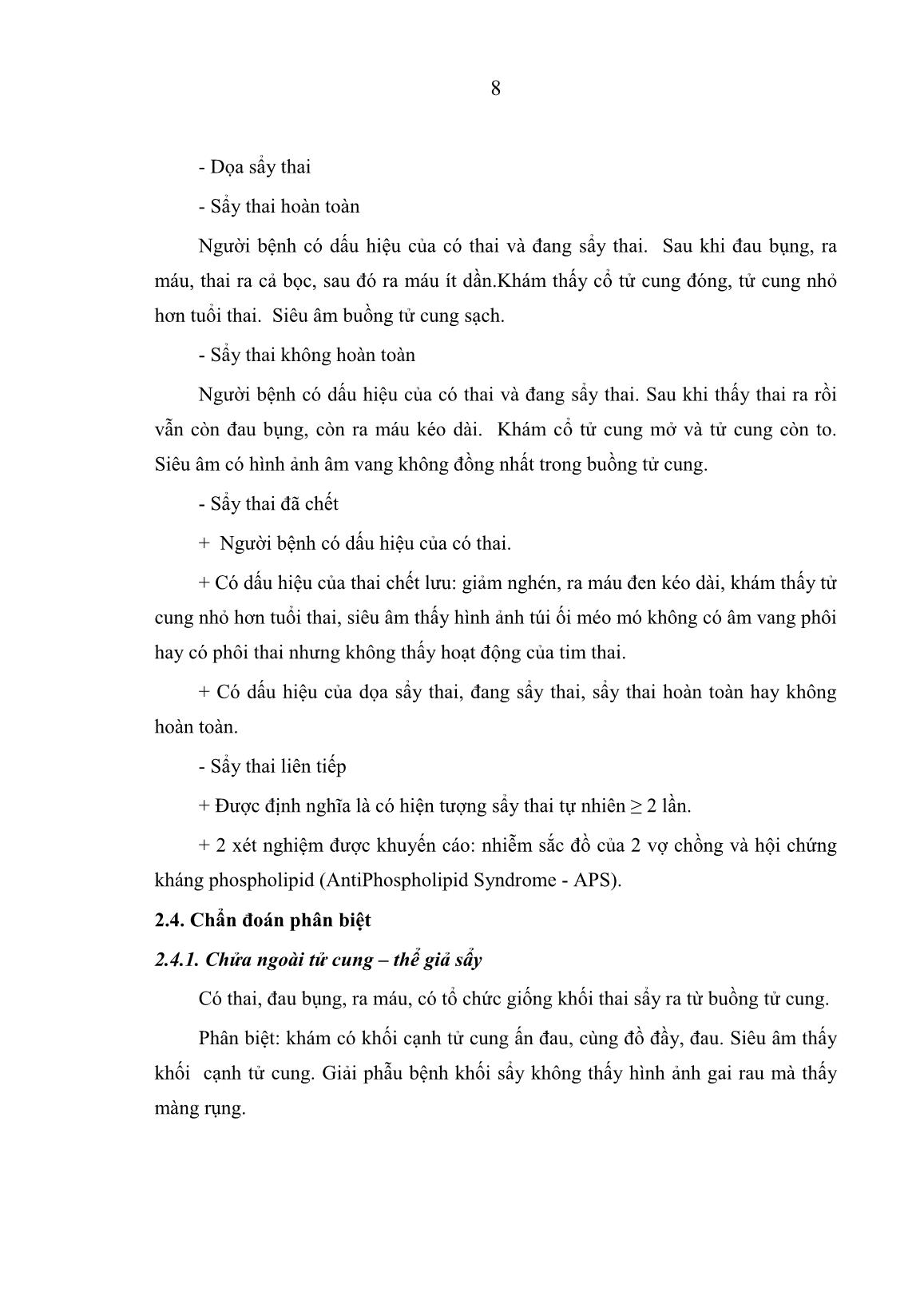
Trang 8
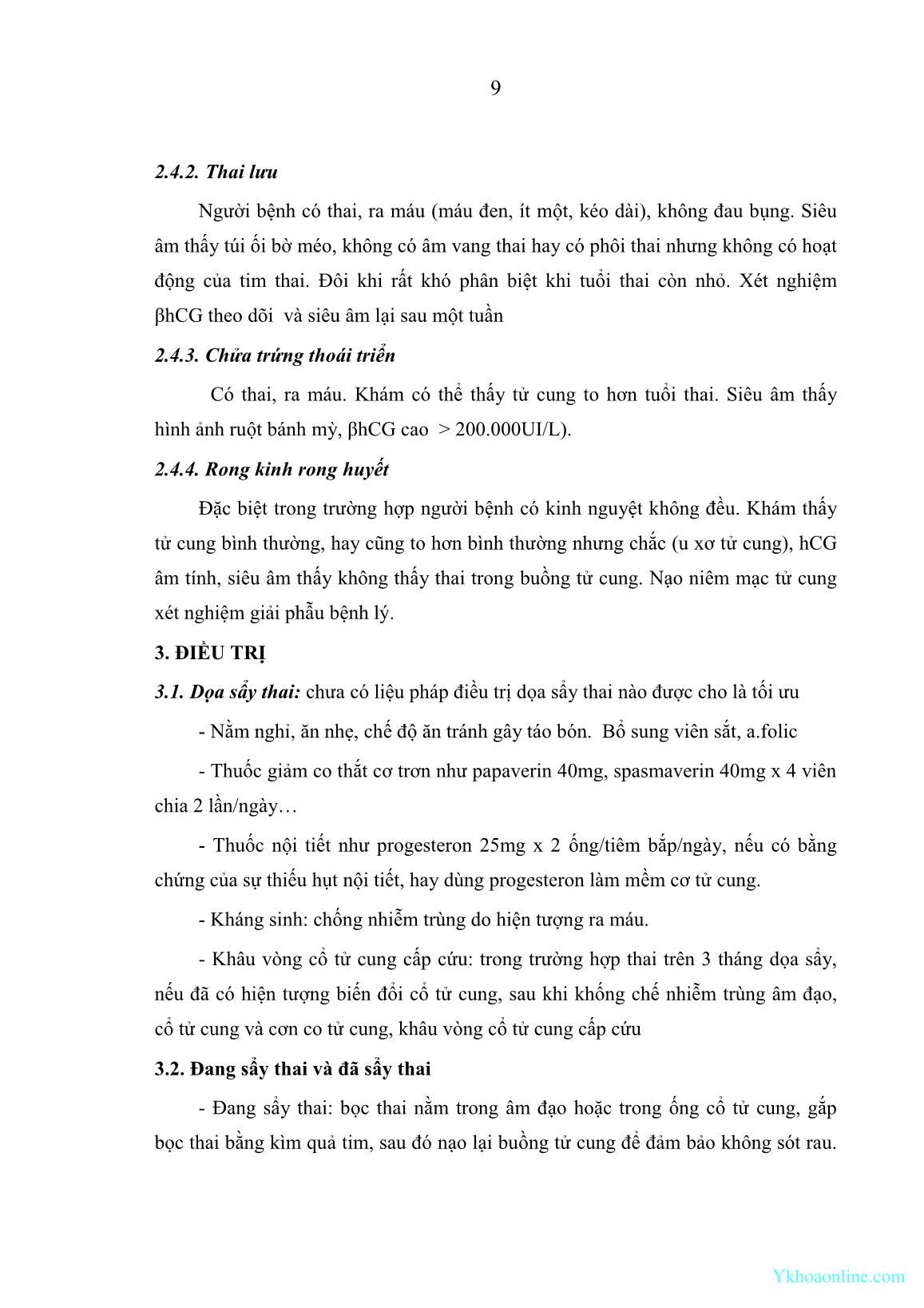
Trang 9

Trang 10
Tải về để xem bản đầy đủ
Bạn đang xem 10 trang mẫu của tài liệu "Giáo trình Hướng dẫn chẩn đoán và điều trị các bệnh sản phụ khoa - Nguyễn Viết Tiến", để tải tài liệu gốc về máy hãy click vào nút Download ở trên
Tóm tắt nội dung tài liệu: Giáo trình Hướng dẫn chẩn đoán và điều trị các bệnh sản phụ khoa - Nguyễn Viết Tiến
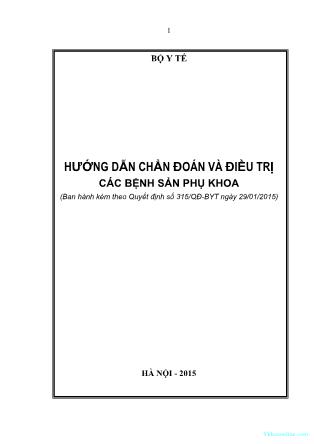
1 BỘ Y TẾ HƯỚNG DẪN CHẨN ĐOÁN VÀ ĐIỀU TRỊ CÁC BỆNH SẢN PHỤ KHOA (Ban hành kèm theo Quyết định số 315/QĐ-BYT ngày 29/01/2015) HÀ NỘI - 2015 Ykhoaonline.com 2 Chủ biên: PGS.TS. Nguyễn Viết Tiến Ban biên soạn: PGS.TS. Nguyễn Đức Hinh PGS.TS. Lƣu Thị Hồng PGS.TS. Lê Hoài Chƣơng PGS.TS. Nguyễn Quốc Tuấn PGS.TS. Trần Danh Cƣờng PGS.TS. Lê Thanh Vân PGS.TS. Nguyễn Vũ Quốc Huy TS. Vũ Bá Quyết THS. Lê Quang Thanh TS. Lê Thiện Thái TS. Lê Hoàng TS. Nguyễn Duy Ánh Ths. Nguyễn Minh Trác Ths. Trần Diệu Linh Ban thƣ ký: Ths. Nguyễn Đức Tiến Ths. Đặng Thị Hồng Thiện Ths. Ngô Thị Bích Hà Ths. Vũ Văn Khanh 3 CHỮ VIẾT TẮT aCL : AntiCardioLipin antibody AĐ : Âm đạo AIDS : Acquired immunodeficiency Syndrom AFI : Amnionic fluid index aPL : AntiPhosphoLipid antibody APS : AntiPhospholipid Syndrome APTT : Activated partial thromboplastin time ALT : Alanine aminotranferease AST : Aspartate aminotransferase CMV : Cytomegalovirus CTM : Công thức máu CRP : C- Reaction Protein HA : Huyết áp hCG : Human chorionic gonadotropin HELLP: H -- hemolysis (the breakdown of red blood cells) EL -- elevated liver enzymes LP -- low platelet count HIV :Human immunodeficiency virus LA : Lupus Anticoagulant antibody LDH : Lactate dehydrogenase LMWH : Low-molecular-weight heparin LNMTC : Lạc nội mạc tử cung MTX : Methotrexat MRI : Magnetic resonance imaging NST : Nhiễm sắc thể PET : Positron emission tomography PGD : Preimplantation genetic diagnosis TM : Tĩnh mạch Ykhoaonline.com 4 MỤC LỤC CHƢƠNG 1: SẢN KHOA ........................................................................................ 7 1. DỌA SẨY THAI – SẨY THAI........................................................................... 7 2. SẨY THAI LIÊN TIẾP ..................................................................................... 12 3. DỌA ĐẺ NON, ĐẺ NON .................................................................................. 17 4. THAI CHẾT LƢU TRONG TỬ CUNG ........................................................... 20 5. THAI CHẬM PHÁT TRIỂN TRONG TỬ CUNG ........................................... 25 6. TIỀN SẢN GIẬT – SẢN GIẬT ........................................................................ 29 7. ĐA ỐI ................................................................................................................ 35 8. THIỂU ỐI .......................................................................................................... 37 9. RAU TIỀN ĐẠO .............................................................................................. 39 10. RAU BONG NON ........................................................................................... 43 11. THAI QÚA NGÀY SINH ............................................................................... 47 12. BỆNH TIM MẠCH VÀ THAI NGHÉN ......................................................... 49 13. THIẾU MÁU VÀ THAI NGHÉN ................................................................... 54 14. BASEDOW VÀ THAI NGHÉN ..................................................................... 56 15. ĐÁI THÁO ĐƢỜNG VÀ THAI NGHÉN ...................................................... 59 16. VIÊM GAN B VÀ THAI NGHÉN ................................................................. 65 17. HIV/AIDS VÀ THAI NGHÉN ....................................................................... 68 18. SỐT TRONG KHI CÓ THAI .......................................................................... 73 19. SINH LÝ CHUYỂN DẠ ................................................................................. 77 20. NGÔI MÔNG .................................................................................................. 82 21. NGÔI VAI ....................................................................................................... 86 22. ỐI VỠ SỚM, ỐI VỠ NON .............................................................................. 88 23. SUY THAI TRONG TỬ CUNG ..................................................................... 93 24. TẮC MẠCH ỐI ............................................................................................... 96 25. VỠ TỬ CUNG ................................................................................................. 99 26. CHẢY MÁU SAU ĐẺ .................................................................................. 103 5 27. NHIỄM KHUẨN HẬU SẢN ........................................................................ 107 CHƢƠNG 2: PHỤ KHOA ................................................................................... 113 1. ÁP XE VÚ ....................................................................................................... 113 2. CÁC TỔN THƢƠNG VÚ ............................................................................... 115 3. TỔN THƢƠNG LÀNH TÍNH CỔ TỬ CUNG ............................................... 123 4. VIÊM PHẦN PHỤ .......................................................................................... 128 5. VIÊM ÂM ĐẠO .............................................................................................. 132 6. CHỬA NGOÀI TỬ CUNG ............................................................................. 135 7. CHỬA Ở VẾT MỔ .......................................................................................... 141 8. SA SINH DỤC ................................................................................................ 143 9. U NANG BUỒNG TRỨNG ............................................................................ 149 10. U XƠ TỬ CUNG (FIBROID) ....................................................................... 154 11. LẠC NỘI MẠC TỬ CUNG .......................................................................... 157 12. TIỀN UNG THƢ VÀ UNG THƢ ÂM HỘ TỔN THƢƠNG TIỀN UNG THƢ . 16 ... tích của hậu môn. Tiến hành phẫu thuật tạo hình hậu môn là 2 thì, thì 1 làm hậu môn nhân tạo, thì 2 làm hậu môn thật sau thì 1 vài tháng. Hậu môn này đƣợc nong dần, đến khi đạt kích thƣớc bình thƣờng sẽ đóng hậu môn nhân tạo Xquang đầu dốc: xác định khoảng cách từ túi cùng đến vết tích hậu môn. 2.3. Thoát vị màng não tủy và tật nứt đốt sống - Vị trí thoát vị hay gặp là vùng cột sống thắt lung (chiếm 80%), vùng chẩm - Tại vị trí thoát vị có một nang phồng lên, bên trong nang chứa dịch não tủy và thông thƣơng với khoang Ykhoaonline.com 276 dƣới nhện + Thể nhẹ: khối thoát vị đƣợc che phủ bằng lớp da và lông hay một u mỡ che phủ bên ngoài + Thể nặng: khi lớp màng não lộ ra ngoài kèm theo dò dịch não tủy - Chăm sóc trẻ tránh làm sang chấn và làm tăng áp lực nơi thƣơng tổn - Phủ gạc ẩm lên chỗ thoát vị, phải dùng gạc tẩm Betadine che phủ vùng thoát vị nếu trƣờng hợp vỡ bao thoát vị - Tránh dây phân vào chỗ thoát vị -Chuyển cơ sở phãu thuật nhi 2.4. Teo tịt lỗ mũi sau - Trẻ sinh ra hoàn toàn không có lỗ mũi sau hoặc có u nang chèn ép gây tịt mũi, hoặc lỗ mũi sau có một màng ngăn có lỗ nhỏ thông qua màng. Có thể bị một hoặc cả hai bên.Có thể kèm theo các dị tật khác. - Triệu chứng lâm sàng: phụ thuộc vào tắc hoàn toàn hay có màng ngăn có lỗ, tình trạng suy hô hấp sẽ rất nặng nếu lỗ mũi bị tịt hoàn toàn. - Chẩn đoán: + Đặt ống thông qua mũi, không luồn sâu ống thông vào qua lỗ mũi sau đƣợc. + Bơm 0.5 ml xanh metylen 1% qua lỗ mũi, dùng đèn soi NKQ không thấy thuốc xuống thành sau họng - Xử trí : cần chuyển ngoại để giải phóng đƣờng thở ngay khi teo tịt hoàn toàn lỗ mũi sau. Trong trƣờng hợp có thể trì hoàn sẽ phẫu thuật khi điều kiện trẻ cho phép từ 4 -12 tháng tuổi. 3. DỰ PHÒNG: 277 - Phụ nữ mang thai tránh tiếp xúc với các tác nhân gây ảnh hƣởng tới quá trình phát triển của thai nhƣ : tia phóng xạ, bức xạ, tác nhân hóa học (Thalidomide, nitrofen, vitamin, thuốc nội tiết), tác nhân nhiễm trùng (Virus, ký sinh trùng, xoắn khuẩn). - Tăng cƣờng chẩn đoán trƣớc sinh để sàng lọc và xử trí sớm các bệnh lý bất thƣờng bẩm sinh. Ykhoaonline.com 278 TÀI LIỆU THAM KHẢO Tiếng Việt 1. Bài giảng Sản phụ khoa tập I (2011), Nhà xuất bản Y học. 2. Bệnh viện Phụ Sản Trung Ƣơng (2012). Sản Phụ khoa- bài giảng cho học viên sau đại học- NXB Y học. 3. Bộ môn Nhi Trƣờng Đại học Y Hà Nội, “ Hội chứng nhiễm khuẩn sơ sinh”, chƣơng II: Sơ sinh; Bài giảng Nhi khoa tập I, 2000, P 171-180. 4. Bộ môn Phụ Sản Trƣờng Đại học Y Hà nội (2006). Bài giảng Sản Phụ khoa dành cho sau đại học- NXB Y học. 5. Bộ môn Phụ Sản Trƣờng Đại học Y Dƣợc Huế. Các tổn thương lành tính cổ tử cung. Trong: Sản Phụ khoa, Nhà xuất bản Y học, Hà Nội, 2007. 6. Bộ môn Phụ Sản Trƣờng Đại học Y Dƣợc Huế. Sa sinh dục. Trong: Sản Phụ khoa, Nhà xuất bản Y học, Hà Nội, 2007. 7. Bộ Y tế- Vụ khoa học Đào tạo (2007). Sản Phụ khoa- NXN Y học. 8. Bộ Y tế. Hướng dẫn sàng lọc, điều trị tổn thương tiền ung thư để dự phòng thứ cấp ung thư cổ tử cung. Hà Nội, 2011. 9. Hội nghị Nhi khoa Việt Nam. Khuyến cáo điều trị dinh dưỡng cho trẻ sinh non,nhẹ cân. Nhà xuất bản tổng hợp TP HCM 18/1/2013. 10. Hƣớng dẫn quốc gia về các dịch vụ chăm sóc sức khỏe (2009), Bộ Y tế. 11. Nguyễn Bá Đức (2002), Ung thƣ buồng trứng (không phải tế bào mầm), Hoá chất điều trị bệnh ung thư, Nhà xuất bản y học, Hà Nội, tr. 130-137. 12. Nguyễn Bá Đức(2008): Chẩn đoán và điều trị bệnh ung thư. 13. Sản phụ khoa tập 1, Bộ môn phụ sản, Đại học Y Dƣợc TP.Hồ Chí Minh: Đa ối; Thiểu ối, trang 308-320 14. Thực hành cấp cứu Nhi khoa, chủ biên GS-TS Nguyễn Công Khanh, GS- TSKH Lê Nam Trà, Chƣơng 3 “Cấp cứu trẻ sơ sinh” Nhà xuất bản Y học Hà Nội. 2010. Trang 287-327 279 15. Viện Hàn lâm Nhi khoa và Hội Tim mạch Hoa Kỳ “ Hồi sức cấp cứu sơ sinh”. Xuất bản lần thứ 5,Nhà xuất bản Y học. 2006 Tiếng Anh 16. Abalos, E, Duley, L, Steyn, DW, Henderson-Smart, DJ. Antihypertensive drug therapy for mild to moderate hypertension during pregnancy (Cochrane Review). Cochrane Database Syst Rev 2007; :CD002252. 17. Adam H Balen (2008). Infertility in Practice. Informa healthcare. 18. ACOG practice bulletin. Diagnosis and management of preeclampsia and eclampsia.Obstet Gynecol. 2002 Jan;99(1):159-67. 19. Alkushi A., Abdul-Rahman Z. H., Lim P., Schulzer M., Coldman A., Kalloger S. E., Miller D. & Gilks C. B. (2005), "Description of a novel system for grading of endometrial carcinoma and comparison with existing grading systems", Am J Surg Pathol, 29(3). 20. American College of Obstetricians and Gynecologists (2008), ACOG Practice Bulletin No. 99: management of abnormal cervical cytology and histology. Obstet Gynecol. 21. American pregnancy Association. Care for the premature Baby. Copy right 2000- 2013 22. Ayhan. B, Mano A, Falcao A, Godinho I, Santos J, Leitao F, Oliveira C, Caramona M (2005), CA-125 AUC as a new prognostic factor for patients with ovarian cancer. Gynecol Oncol;97:529–534. 23. Basta A. Decidual ectopy of the uterine cervix. In: The Cervix, 2nd ed. Blackwell Publishing, 2006. 24. Bardara Wilson- Clay. Breastfeeding premature babies_ the importance of breastmilks. babies/breatsfeeding.1/16/2013 25. Berkowitz R. S, Goldstein D. P (2003).“Gestational trophoblastic Disease", Novak ' s Gynecology13th, Chapter Ykhoaonline.com 280 26. Bump RC, Mattiasson A, Bo K, et al. The standardization of terminology of female pelvic organ prolapse and pelvic floor dysfunction. Am J Obstet Gynecol.1996;175:13. 27. Brubaker L et al. Pelvic Organ Prolapse. In: Incontinence. International Continence Society, 2009. 28. Christianne, A.L., A.C. Ansink (2006), Treatment and prognosis of post term choriocarcinoma in The Netherlands, Gynecologic Oncology. 29. Copeland LJ, Landon MB (2012), Malignant diseases and pregnancy. In: Gabbe SG, Niebyl JR, Simpson JL, eds. Obstetrics - Normal and Problem Pregnancies. 6th ed. Philadelphia, PA: Elsevier Saunders; chap 47. 30. Claudio Chiesa, Alessandra Panero, John F. Osborn, Antonella F. Simonetti, Lucio Pacifico, Diagnosis of neonatal sepsis: A clinical laboratory challenge. Clinical chemistry 50, No.2, 2004. P. 279-287 31. Creasman William T (2007), "Clinical gynecologic oncology", Elsevier Inc. 32. Current Diagnosis and Treatement Obstetrics and Gynecology. 10th edition- McGraw-Hill 2007. 33. David B. Seifer; Robert L. Collins (2002). Office-Based Infertility Practice. Springer-Verlag New York. 34. David EF, John BP, Chapter 2 “Resuscitation of the newborn infant”. In: Care of the high risk neonate, Third edition, 1986. P31-51 35. Davila GW, Ghoniem GM, Wexner SD. Pelvic Floor Dysfunction. Springer, London, 2006. 36. Desai NR, Gupta S, Said D et al (2010), Choriocarcinoma in a 73 year-old woman : a case report and review of the literature. J med Case Report. 37. Duley, L, Henderson-Smart, DJ, Meher, S. Drugs for treatment of very high blood pressure during pregnancy. Cochrane Database Syst Rev 2006; 3:CD001449. 38. Edmund S. Sabanegh (2010). Male Infertility: Problems and Solutions. Humana Press. 281 39. Franco Muggia & Esther Oliva (2009), "Uterine Cancer Screening, Diagnosis, and Treatment", Humana Press. 40. F.Gary Cunnningham, Williams Obstetrics (2005) 22Th ed, Mc GRAW – HILL, p 761-798 41. F.Gary Cunnningham, Williams Obstetrics (2009) 23Th ed, Mc GRAW – HILL, chapter 34. 42. Fortnightly review: management of hypertension in pregnancy. BMJ 1999 May 15;318(7194):1332-6. 43. Gaetano Clirico, Cristina Lada. “ Laboratory and to the diagnosis and therapy of infection in the neonate”. Pediatic Reports 2011; Volume 3; e1 44. Ghoniem GM, Davila GW. Practical Guide to Female Pelvic Medicine. Taylor & Francis, London, 2006. 45. Gilad Twig et al. Anti Phospho Lipid Syndrome- pathophysiology. Recurrent Pregnancy Loss- Cause, Controversies and Treatment. Iforma Helth Care, 2007: 107-114. 46. Goldstein DP, Berkowitz RS (2008), Gestational trophoblastic disease. In: Abeloff MD, Armitage JO, Niederhuber JE, Kastan MB, McKenna WG, eds. Abeloff’s Clinical Oncology. 4th ed. Philadelphia, PA: Elsevier Churchill Livingstone; chap 94. 47. Hoffman B, et al. Benign disorders of the lower reproductive tract. In: Williams Gynecology, The McGraw-Hill Companies, Inc, 2012. 48. Hope S. Consultation for an abnormal menstrual cycle. In: The abnormal menstrual cycle. Rees M, Hope S, RavnikarV (editors). Taylor & Francis, UK, 2005. 49. Huang KG, Abdullah NA, Adlan AS, Ueng SH, Ho TY, Lee CL (2013), Successful surgical treatment of recurrent choriocarcinoma with laparoscopic resection of intraperitoneal pelvic tumor. Taiwan J Obstet Gynecol. 2013 Jun;52(2). Ykhoaonline.com 282 50. International Federation of Gynecologists and Obstetricians (FIGO) (2000). "Staging classification and clinical practice guidelines of gynaecologic cancers". 51. Iurain JR (2007), " Berek & Novak's Gynecology", Lippincott Williams & Wilkins. 52. Ivan Damjanov (2013), Cancer Grading. Manual ISBN 978-3-642-34515-9 ISBN 978-3-642-34516-6.Springer Heidelberg New York Dordrecht London. 53. James P Neilson, Gillian ML Gyte,Martha Hickey, Juan C Vazquez, Lixia Dou (2013) ”Medical treatments for incomplete miscarriage”, Chochrane database Syst Rev.2013 Mar 28;3:CD007223 54. Jiang W, Lv S, Sun L, Singer G, Xu C, Lu X (2013), Diagnosis and Treatment of Retroperitoneal Ectopic Pregnancy: Review of the Literature. Gynecol Obstet Invest. 2013 55. Joyce M.K, WilliamJ.K “ Group B Streptococcus and Early – Onset Sepsis in the Era of maternal Prophylaxis”. Pediatr Clin North Am. 2009 June; 56(3): 689 – Contents. Doi: 10.1016/J.Pcl.2009.04.003 56. Jurkovic D., Hillaby K., Woelfer B., Lawrence A., Salim R., Elson C.J. Cesarean scar pregnancy Ultrasound Obstet Gynecol 2003 ; 21 : 220-227 57. Kavanagh JJ, Gershenson DM (2012), Gestational trophoblastic disease: hydatidiform mole, nonmetastatic and metastatic gestational trophoblastic tumor: diagnosis and management. In: Katz VL, Lentz GM, Lobo RA, Gershenson DM, eds.Comprehensive Gynecology. 6th ed. Philadelphia, PA: Elsevier Mosby; chap 35. 58. Kamura T, Ushijima K (2013), Chemotherapy for advanced or recurrent cervical cancer. Taiwan J Obstet Gynecol. 59. Kimmig R, Wimberger P, Buderath P, Aktas B, Iannaccone A, Heubner M (2013). 60. Kumar, Vinay, ed. (2010). Pathologic Basis of Disease(8th ed.). Saunders Elsevier 283 61. Larsen J.V., Solomon M.H. Pregnancy in a uterine scar sacculus–an unusual cause of postabortal haemorrhage. A case report S Afr Med J 1978 ; 53 : 142-143 62. Lewis V. Reproductive Endocrinologyand Infertility. Lasndes Biosciences, Texas, 2007. 63. Mayeaux Jr. EJ, Cox JT. Modern Colposcopy Textbook and Atlas. American Society for Colposcopy and Cervical Pathology, 2011. 64. Mayo Clinic.com. Premature birth: Complications 65. Maymon R., Halperin R., Mendlovic S., Schneider D., Vaknin Z., Herman A., and al. Ectopic pregnancies in caesarean section scars: the 8-year experience of one medical centre Hum Reprod 2004 ; 19 : 278-284 66. National Cancer Institute (27 June, 2005). "Paget's Disease of the Nipple: Questions and Answers". Retrieved 2008-02-06. 67. Nancy K. Lowe (2013), Cervical Cancer Screening Guidelines 2012 Journal of Obstetric, Gynecologic, & Neonatal Nursing. Volume 42, Issue 1. 68. Ngan, H., L.-C. Wong (2003), Staging and classification systems, Gestational trophoblastic disease, Chapman & Hall Medical, London - New York – Tokyo. 69. Noller KL (2007), Intraepithelial neoplasia of the lower genital tract (cervix, vulva): Etiology, screening, diagnostic techniques, management. In: Katz VL, Lentz GM, Lobo RA, Gershenson DM, eds. Comprehensive Gynecology . 5th ed. Philadelphia, Pa: Mosby Elsevier. 70. Novak‟s Textbook of Obstetrics, 14th edition. 70. Obrtetrics: Normal and Problem Pregnancies. Sixth edition- Saunder Elsevier 2012. 71. Pak Cheung Ng. Diagnostic markers of Infection in neonates, Review. Arch Dis Child Fetal Neonatal Ed 2004; 89: F229-F235. 72. Peter Braude; Alison Taylor (2003). ABC of subfertility: Extent of the problem. BMJ. Ykhoaonline.com 284 73. Trachtenbarg DE, Goleman TB. Do premature babies need special care? May 15, 1998. Created 01/1999. 74. Tscherne, G. Menstrual Irregularities. In: Pediatric and adolescent gynecology: evidence-based clinical practice, SultanC (edit.). Karger, Basel, 2004. 75. Sierra B, Sanchez M, Cabrerizo JL et al (2008), Choriocarcinoma with pulmonary and cerebral metastases. Singapore Med J. 76. Stage Information for Gestational Trophoblastic Tumors and Neoplasia at The National Cancer Institute (NCI), part of the National Institutes of Health (NIH), in turn citing: FIGO Committee on Gynecologic Oncology.: Current FIGO staging for cancer of the vagina, fallopian tube, ovary, and gestational trophoblastic neoplasia. Int J Gynaecol Obstet 105 (1), 2009. 77. Scully RE, Sobin LH (2003), Histological typing of ovarian tumors. Second Edit. Wolrd Health Organization, International Histological Classification of Tomours. Springer. 78. Sergio C Oehninger; Thinus F Kruger (2007). Male Infertility: Diagnosis and Treatment. Informa healthcare. 79. Siriwan Tangjitgamol & al (2009), "Management of endometrial cancer in Asia: consensus statement from the Asian Oncology Summit 2009", the Lancet oncology. 80. Raymond E.L., Robert T.O., Ted G. (2001), Ovarian and fallopian tube cancers, Clinical Oncology, American Cancer Sosiety, pp. 477-486. 81. Recurrent Pregnancy loss Causes, Controversies and Treatment Informa, 2007. 82. Vulvar Cancer - October 1, 2002 - American Family Physician". Retrieved 2010-006. 83. "Vulvar Cancer". Gynecologic Neoplasms. Armenian Health Network, Health.am. 2005. Retrieved 2007-11-08.
File đính kèm:
 huong_dan_chan_doan_va_dieu_tri_cac_benh_san_phu_khoa_nguyen.pdf
huong_dan_chan_doan_va_dieu_tri_cac_benh_san_phu_khoa_nguyen.pdf

